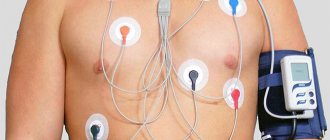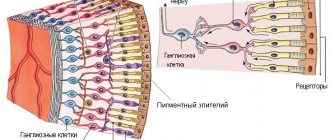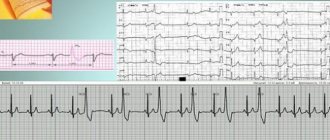5 / 5 ( 2 voices)
Myocardial degeneration (dystrophy) is a pathological condition of the heart in which its functioning is disrupted (myocardial dysfunction) as a result of the development of various pathological processes. In simple words, cardiac dysfunction occurs due to certain diseases or disorders in the human body.
According to generally accepted coding, the disease has ICD 10 code – I51.5. The cause of myocardial degeneration may be another disease or old age.
Myocardial dystrophy
Causes of myocardial dystrophy
The etiology of myocardial dystrophy causes much debate among doctors. Experts believe that the list of causes of metabolic disorders in the heart is extremely wide.
Heart nutritional disorders, as a result of which the cells do not receive enough oxygen and nutrients.
- violation of coronary circulation;
- chronic pulmonary heart disease;
- anemia, hemoglobin level in the blood less than 90-80 g/l;
- altitude sickness;
- arterial hypertension;
- heart defects;
Nervous tension , leading to a significant increase in adrenaline and excessive work of the heart;
- prolonged stress;
- depression;
- neuroses;
Excessive physical activity
- excessive loads in trained athletes;
- intense physical activity in untrained people
- intense physical activity during the period after infectious diseases (sore throat, flu);
Chronic diseases of the digestive system leading to nutritional deficiencies;
- pancreatitis;
- cirrhosis;
- malabsorption syndrome (malabsorption in the intestine);
Eating disorders accompanied by electrolyte imbalance;
- avitaminosis;
- diets with minimal protein and minerals;
Metabolic disorders. Common diseases affect the heart;
- renal and liver failure;
- gout;
- diabetes;
- obesity;
Hormonal disorders. High concentrations of hormones increase heart rate. During intense work, the energy reserves of the myocardium are depleted.
- thyrotoxicosis;
- Cushing's disease;
- menopause;
- puberty;
Poisoning with toxins that damage myocardial cells or disrupt metabolic processes.
- alcohol;
- nicotine;
- drugs;
- taking medications (cardiac glycosides);
- industrial poisons;
The causes of myocardial dystrophy in newborns are:
- oxygen starvation of the fetus;
- intrauterine infections;
- perinatal encephalopathy;
Forecast
Depending on the nature of the pathology, myocardial degeneration may or may not be curable. If the primary disease can be eliminated, then complete or partial recovery is possible. Usually nothing threatens life, but if the disease progresses to acute heart failure, then the person may die in the coming years.
Violating doctors' recommendations can also cause death. Athletes often die by ignoring acceptable standards during competitions or training.
Toxic and dishormonal myocardial dystrophy are most treatable; diseases associated with genetic pathologies are much more difficult to treat. For alcoholics (provided they completely stop drinking ethanol), it will take quite a long time before the heart begins to recover.
Mechanism of development of myocardial dystrophy
The mechanism of development of myocardial dystrophy does not depend on the cause of the disease. It includes the following steps.
- Violation of the nervous and hormonal regulation of the heart. The heart is under the influence of adrenaline and the sympathetic nervous system. They increase the contraction of the heart and gradually lead to its exhaustion.
- The heart absorbs oxygen worse. At the same time, the myocardial need for oxygen increases.
- A number of changes occur inside the heart cells: calcium levels increase, which disrupts the relaxation of myofibrils. Tissue respiration worsens. Calcium-dependent proteases are activated. These are substances that destroy the structures (mitochondria, myofibrils) of heart cells.
- As a result of impaired fat metabolism, free radicals accumulate in cells, which continue to destroy the myocardium.
- Enzymes are released from damaged lysosomes that destroy the cell structure.
- As a result of these processes, the number of functioning cardiomyocytes and cells of the cardiac conduction system is sharply reduced.
Clinical manifestations
The initial stages of the disease occur in a latent form. The clinical picture begins to appear when a person already has pathologies and heart failure develops.
The first signs should be the appearance of shortness of breath, lack of air during physical activity and rapid fatigue. Although these symptoms do not always alarm patients, and the cost of lost time is irreparably high.
Following these manifestations, over time the symptoms become more clear. The heart begins to ache, patients note the constant aching nature of the sensations that appear.
As a rule, the discomfort is intermittent at first. Then the person himself, without analyzing instruments, begins to feel a disturbance in the heartbeat, tachycardia develops, and the lower extremities begin to swell.
Acute myocardial dystrophy during sports activities
Strength exercises during long periods of exercise and heavy loads cause rapid wear and tear of the heart muscles
Excessive exercise over a long period of time depletes the heart. During training, it works harder and wears out faster (pulse up to 200 beats per minute, the myocardium does not have time to rest, there is no diastole).
The myocardium and other muscles feel a lack of energy; the cells are poisonously affected by excess lactic acid, which accumulates due to insufficient gas exchange in the cells. As a result, the muscles begin to be partially replaced by connective tissue, which prevents the heart from functioning fully.
During competitions, significant training, or non-compliance with a sports regime, a person may experience a crisis due to the inability of the heart to withstand the increased load.
Symptoms will be as follows:
- shortness of breath;
- dizziness;
- increased heart rate;
- muscle pain;
- nausea and vomiting;
- in especially severe cases, loss of consciousness or the onset of a borderline state is possible.
Such symptoms cannot go unnoticed by doctors. The athlete must stop training and be at rest, as otherwise there may be a threat to life. After a comprehensive examination, the doctor makes a decision on acceptable sports activities.
Note. The symptoms of a heart attack differ from a crisis during myocardial degeneration in that the pressure decreases, acute pain occurs in the heart area, and the patient may cough.
Treatment of myocardial dystrophy
Treatment of myocardial dystrophy is aimed at normalizing metabolic processes in the myocardium, improving heart nutrition and eliminating the underlying disease that caused dystrophy.
In our Medical City Alexandrov, the appointment is conducted by an experienced cardiologist, a high-class specialist who will conduct a comprehensive diagnosis of the disease and prescribe the necessary treatment.
By contacting us, you can be sure of a quality result!
To make an appointment with a specialist and find out all the details, please call: 8 (49244) 9-32-49
Classification
Alcoholic cardiomyopathy
Degenerative changes in the myocardium have several varieties, depending on the specifics of the disease and its location.
Types of cardiac dystrophy:
- Myocardial dystrophy in athletes. The causes and symptoms are described in the previous section;
- Focal (ischemic) dystrophy occurs due to the cessation of blood circulation in full through important arteries. It is often asymptomatic, but can cause pre-infarction conditions that are painless. This form is considered a borderline state between a heart attack and tachycardia;
- Dishormonal. The reason for the development is hormonal changes as a result of endocrine or diseases of the reproductive system;
- Tonsillogenic myocardial degeneration occurs as a result of the presence of streptococcal infection, the source of which is inflamed tonsils. In this case, the protein of the heart valves is similar to the protein of bacteria, so they are attacked by immune cells;
- Senile myocardial degeneration – age-related anatomical changes in the heart muscle;
- Alcoholic dystrophy or bull's heart is characteristic of persons suffering from alcoholism. The disease is manifested by shortness of breath and cardiac rhythm disturbances;
- Diffuse dystrophy is the presence of inflammation for various reasons.
Signs of illness
Myocardial dystrophy has the following symptoms:
- easy fatigue, malaise;
- asthmatic manifestations even with light exertion;
- frequent heart pain, heart rhythm disturbances, interruptions in heart function;
- manifestation of atypical changes on the ECG.
Often the general manifestations of myocardial dystrophy are hidden behind the manifestations of the underlying disease; it became a consequence of this pathology. So after thyrotoxicosis, arrhythmia, high blood pressure, and tachycardia appear. Due to anemia, a murmur may be heard over the lungs. After mexidemia, shortness of breath, decreased heart rate, and hypotension are noted.
Myocardial dystrophy with the described symptoms requires full treatment under the supervision of a cardiologist.
Read also
Hypertension - high blood pressure
Hypertension (often called primary hypertension or essential hypertension) is a chronic disease, a typical symptom of which is a persistent increase in blood pressure...
Read more
Frequent increases in blood pressure
Frequently high blood pressure is a common condition in which the long-term effect of blood flow on the arterial walls is high enough that it can cause problems in the future...
More details
Angina pectoris
What is angina? Angina is chest pain caused by decreased blood flow to the heart. The condition is often described as squeezing, pressure, heaviness, squeezing, or pain behind the breastbone. Part…
More details
Cardiomyopathy and its types
Cardiomyopathy is a heart disease that causes the heart muscle to weaken, impeding cardiac output and interfering with normal blood flow. This condition can lead to heart failure.…
More details
Hypotension
What is hypotension Hypotension, or low blood pressure, is most often not considered a serious disease because in many people it is asymptomatic. However, some...
More details
Our specialists
Shcherbakova Lyudmila Aleksandrovna
The doctor is a cardiologist of the highest category. Candidate of Medical Sciences.
Experience: 23 years.
Gabrielyan Julietta Grigorievna
The doctor is a cardiologist of the highest category. Candidate of Medical Sciences. Experience: 25 years
Logacheva Olga Alexandrovna
The doctor is a cardiologist of the first category. Functional diagnostics doctor. Experience: 17 years.
Roshchina Ekaterina Anatolevna
Functional diagnostics doctor of the second category. Ultrasound diagnostics doctor. Cardiologist. Experience: 15 years.
Prevention
Get regular examinations for early diagnosis of heart pathologies
Preventing a disease is much easier than treating it. Doctors recommend not to overwork yourself in sports, especially for amateur activities, where there is no constant supervision from doctors. If a person is exposed to stress for a long time, then an ECG should be done.
Treat endocrine diseases in a timely manner; in case of frequent sore throats and chronic tonsillitis, it is better to completely remove the tonsils. Do not prescribe medications on your own, carefully monitor the general condition of your body and lead a healthy lifestyle.










